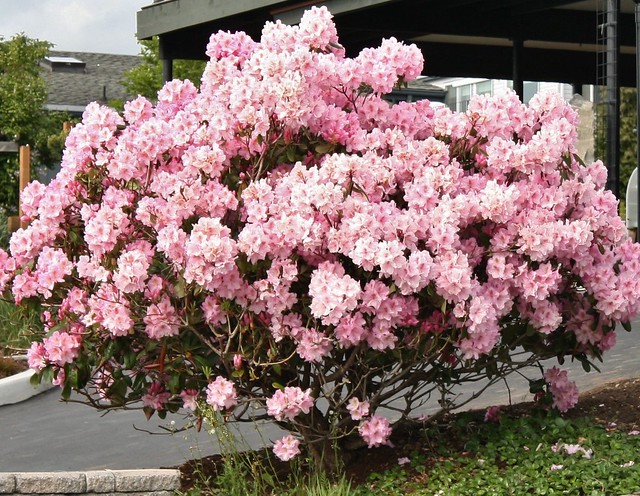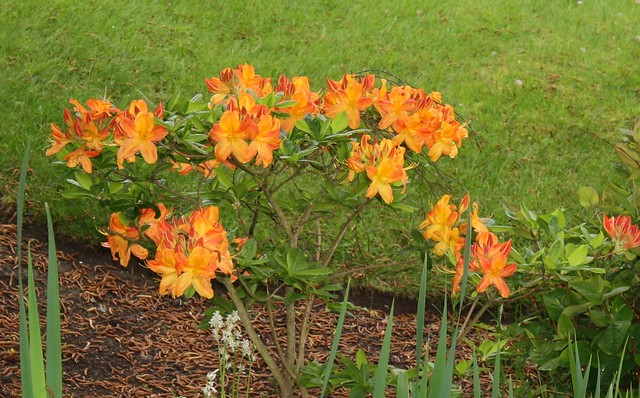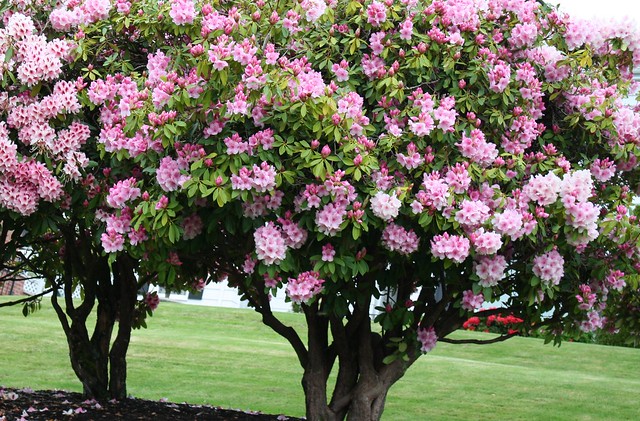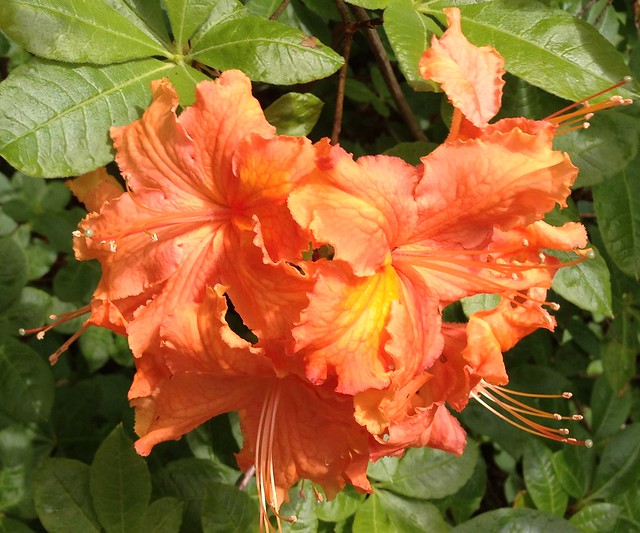I post a weekly diary of historical notes, arts & science items, foreign news (often receiving little notice in the US) and whimsical pieces from the outside world that I often feature in “Cheers & Jeers”. For example:
SEPARATED at BIRTH – TV stars Minka Kelly (“Friday Night Lights”, “Almost Human”) and Leighton Meester (“Gossip Girl”).


OK, you’ve been warned – here is this week’s tomfoolery material that I posted.
ART NOTES – fabrics and clothes by the famous fashion designer – as well as photos and paintings by his friend, the pop artist – are combined in the exhibit Halston and Warhol at the Andy Warhol Museum in Pittsburgh, Pennsylvania through August 24th.

END of an ERA – with the retirement of Rep. John Dingell (D-MI), and this week’s primary loss of Rep. Ralph Hall (R-TX), there will no longer be any WW-II veterans in Congress this coming January, 2015.
LEST YOU THINK that this is merely a fixation with the US Christian Right – clerics in Iran are also perturbed by the rising popularity of yoga among its female population.
THURSDAY’s CHILD breaks new ground. Last decade, the California Angels … or was it Anaheim Angels baseball team had a Rally Monkey scoreboard image, exhorting fans to cheer the Angels to rally for a come-from-behind victory. They wound up as 2002 World Series champs.
Just recently they used a Rally Cat – and danged if the tuxedo kitteh’s image didn’t precede a Los Angeles Angels of Anaheim victory (with a walk-off home run by Mike Trout).

GLAD to see that later this year the British Museum will have a retrospective on the history of Germany; explaining how its history explains its current influential role on the European continent.
BRAIN TEASER – try this Quiz of the Week’s News from the BBC.
IN EXPLAINING why his 1960 album The Button-Down Mind of Bob Newhart became such a hit – winning the 1961 Grammy Album of the Year and which remains in the Top 20 best-selling comedy albums of all time – the still-performing 84 year-old entertainer posits:
“I was just in the right place at the right time. I have a theory: It was aimed at college people. Nightclubs became very expensive. They had cover charges, and they priced-out the college kids at that time. Besides that, the humor [in clubs] wasn’t being directed at them, at their areas of concern, anything having to do with their life. It was mother-in-law jokes, ‘Take my wife, please.’ So they sort of set-up their own nightclub, in their dorm.”
FRIDAY’s CHILD is Tommy the Cat – a New Hampshire kitteh who survived a ride in a vehicle’s engine block … and despite some severe burns, Tommy is recuperating and will be up for adoption if unclaimed.

400 YEARS AGO a town in Spain had its named changed from Castrillo Mota de Judíos (or Hill of Jews) to Castrillo Matajudíos (or Fort Kill the Jews) after the Spanish Inquisition. This past weekend, the tiny town held a referendum to change the name back to its original name ….. and mercifully it passed by a 29-19 vote.
ALTHOUGH THIS ESSAY is nearly two years old, it describes the older man/younger woman dynamic that drives the Fox network – read the entire piece, here is an excerpt:
(It’s) hardly a revelation that some networks place more pressure on women than do others: C-SPAN has no makeup room at all, just a collection of powder compacts that guests can use if they are so inclined. At MSNBC, Rachel Maddow is known to prefer minimal makeup, while other anchors want more, and the artists oblige with a range of choices, from neutral tones to berry hues. Bloomberg TV tends toward the corporate aesthetic; CNN favors a professional style that makes women and men look crisp, as if they have been ironed.
As for Fox, suffice it to say that there is a YouTube montage devoted to leg shots of Fox anchors, who are often outfitted in body-hugging dresses of vibrant red and turquoise, their eyes enhanced by not only liner and shadow but also false lashes. A Fox regular once commented to me that she gets more calls from network management about her hair, clothes, and makeup than about what she says. “I just think of it as a uniform,” she said of her getup.
SEPARATED at BIRTH – TV stars Minka Kelly (“Friday Night Lights”, “Almost Human”) and Leighton Meester (“Gossip Girl”).


…… and finally, for a song of the week …………………… someone whose potential in the music business was reaching its peak … and then largely walked away from it was Fred Neil – one of the pioneering folk-rock performers in the burgeoning Greenwich Village scene of the 1960’s, whose songs were more notably performed by others .. yet who dedicated much of his life from 1970 on to animal welfare, when he could have been a leading figure of the singer-songwriter era. He had a low voice (caramel flavored, in one reviewer’s description) and a 12-string guitar sound that made him an influence on young performers, whom he was happy to help.
Born in Cleveland, Ohio in 1936 to a father who was a traveling sales rep for the Wurlitzer jukebox company, he grew up in St. Petersburg, Florida. Later he became a songwriter in NYC’s Tin Pan Alley; working in the famous Brill Building on Broadway (where many songwriters including Carole King worked over the years). He had two early successes in that regard: with Buddy Holly recording his “Come Back Baby” in 1958, and on the B-side of his famous 1961 song “Crying”, Roy Orbison recorded “Candy Man” by Fred Neil. During the late 50’s, Neil recorded some singles in a different style (rockabilly-pop) that many of his later fans might find a bit surprising – such as Listen Kitten (while still working at his day job).
It was in 1961 that he began his career in earnest, forming a duo with Vince Martin just as the folk-boom was coming into its own. He befriended newer arrivals, such as Bob Dylan (who sometimes joined Neil’s duo on harmonica), Buzzy Linhart and David Crosby. In his memoirs, Richie Havens noted Neil’s early performances and his friendship.
The duo’s first album was Tear Down the Walls – an all-acoustic recording from 1964, with his updated version of Candy Man and with guest appearances by John Sebastian and future Mountain bassist Felix Pappalardi. The next year’s breakthrough album Bleecker and MacDougal – with some electric instrumentation – was what Richie Unterberger of the All-Music Guide considered his bluesiest effort, with songs such as Little Bit of Rain. Then 1966 saw his self-titled album which contained his two most famous tunes.
One was a song that his friend Harry Nilsson (who was also reclusive and reluctant to tour) made into a hit. Everybody’s Talking became a Top Ten hit in 1969 and was a main theme for the film Midnight Cowboy starring Dustin Hoffman and Jon Voight.
The other portended his future path after music. Having visited aquariums since childhood, “The Dolphins” became a hit for Tim Buckley and has an allegorical quality to it. One writer for The Guardian says the song reminds him of his late father, with a “Why Can’t We All Get Along?” quality, yet much richer … and how his father’s appreciation for Tim Buckley’s version led him to discover the original (which at this link you can hear).
It was at this time that Neil began to tire of his growing popularity – and it showed in his 1967 album Sessions which was less song-oriented and more instrumental. Then in 1970 he co-founded the Dolphin Research Project – to alert the public of the dangers of dolphin exploitation – which became his primary focus for the remainder of his life.
He did some recording sessions during the 1970’s, many of which remain unreleased along with his last release (a half-live, half studio album from 1971). During the 70’s, his (comparatively) few performances were often benefits for his foundation, with his final public appearance taking place in 1981. In addition to his reclusiveness – his obscurity was compounded by a lack of CD re-issues (in North America) of his 1960’s work, which only changed in his later years.
Fred Neil died in July, 2001 of skin cancer at the age of 65. “Hardly anyone even knew where he was or if he was still alive”, as Anthony DeCurtis of Rolling Stone put it, and David Crosby observed, “He just didn’t fit in this commercial world.” Fortunately there is an excellent compilation album of his music available (left photo, below).
But besides his songs made famous by others, his legacy is that of the many musicians who have cited his influence on them. These include: Jesse Colin Young, Paul Kantner of the Jefferson Airplane, Tim Hardin, Judy Henske, John Sebastian, Stephen Stills, Jerry Jeff Walker … and bands such as The Monkees and the Flying Burrito Brothers. And so while Fred Neil’s career does have a “What if?” aspect to it: he didn’t vanish without a trace, with David Crosby summing-it-up best: “He taught me that everything was music”.


Of all of his songs, my favorite is one that Paul Kantner made famous by the live recording he and the Jefferson Airplane made of The Other Side of This Life – for which at this link you can hear (in a much heavier version). Meanwhile, below you can hear Fred Neil’s original folk-rock version from 1967.
Would you like to know a secret?
It’s just between you and me
I don’t know where I’m going next
I don’t know where I’m gonna beWell, my whole world’s in an uproar
My own world’s upside down
I don’t know where I’m going
But I’m always bumming aroundWell, I don’t know what I’m doing
Half the time I don’t know where I’ll go
I think I’ll get me a sailing boat
And sail the gulf of MexicoBut that’s the other side of this life
I’ve been leading
That’s the other side of this life




















































